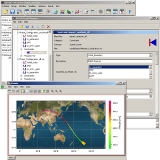
Astos
Encyclopedia
ASTOS is a Trajectory optimization
and simulation
tool for launch
and re-entry
missions, orbit transfers
, design optimization and for re-entry safety assessments. It solves Aerospace
problems with a data driven interface and automatic initial guesses. Since 1989, the European Space Agency
has developed, and improved this trajectory optimization environment to compute optimal trajectories for a variety of complex multi-phase Optimal control
problems. ASTOS is being extensively used at ESA and aerospace industry community to calculate optimal launch and entry trajectories and was one of the tools used by ESA to assess the risk due to the ATV
'Jules Verne'
re-entry. ASTOS is compatible with Windows
, Linux
and Mac OS
platforms and is maintained and commercialized by Astos Solutions GmbH for the European Space Agency.
In 1991 the Institute of Flight Mechanics and Control (IFR) at the University of Stuttgart
under the head of Prof. Klaus Well took the responsibility for the development of ASTOS. In 1999 the commercialization of ASTOS began. In the period 2001-2006 ASTOS was sold by Technology Transfer Initiative of the University of Stuttgart (TTI). Since September 2006 the newly founded company Astos Solutions GmbH is responsible for development and sales of ASTOS.
Trajectory optimization
Trajectory optimization is the process of designing a trajectory that minimizes or maximizes some measure of performance within prescribed constraint boundaries...
and simulation
Computer simulation
A computer simulation, a computer model, or a computational model is a computer program, or network of computers, that attempts to simulate an abstract model of a particular system...
tool for launch
Launch vehicle
In spaceflight, a launch vehicle or carrier rocket is a rocket used to carry a payload from the Earth's surface into outer space. A launch system includes the launch vehicle, the launch pad and other infrastructure....
and re-entry
Atmospheric reentry
Atmospheric entry is the movement of human-made or natural objects as they enter the atmosphere of a celestial body from outer space—in the case of Earth from an altitude above the Kármán Line,...
missions, orbit transfers
Orbital maneuver
In spaceflight, an orbital maneuver is the use of propulsion systems to change the orbit of a spacecraft.For spacecraft far from Earth—for example those in orbits around the Sun—an orbital maneuver is called a deep-space maneuver .-delta-v:...
, design optimization and for re-entry safety assessments. It solves Aerospace
Aerospace
Aerospace comprises the atmosphere of Earth and surrounding space. Typically the term is used to refer to the industry that researches, designs, manufactures, operates, and maintains vehicles moving through air and space...
problems with a data driven interface and automatic initial guesses. Since 1989, the European Space Agency
European Space Agency
The European Space Agency , established in 1975, is an intergovernmental organisation dedicated to the exploration of space, currently with 18 member states...
has developed, and improved this trajectory optimization environment to compute optimal trajectories for a variety of complex multi-phase Optimal control
Optimal control
Optimal control theory, an extension of the calculus of variations, is a mathematical optimization method for deriving control policies. The method is largely due to the work of Lev Pontryagin and his collaborators in the Soviet Union and Richard Bellman in the United States.-General method:Optimal...
problems. ASTOS is being extensively used at ESA and aerospace industry community to calculate optimal launch and entry trajectories and was one of the tools used by ESA to assess the risk due to the ATV
Automated Transfer Vehicle
The Automated Transfer Vehicle or ATV is an expendable, unmanned resupply spacecraft developed by the European Space Agency . ATVs are designed to supply the International Space Station with propellant, water, air, payload and experiments...
'Jules Verne'
Jules Verne ATV
The Jules Verne ATV, or Automated Transfer Vehicle 001 , was an unmanned cargo resupply spacecraft launched by the European Space Agency . The ATV was named after the French science-fiction author Jules Verne...
re-entry. ASTOS is compatible with Windows
Microsoft Windows
Microsoft Windows is a series of operating systems produced by Microsoft.Microsoft introduced an operating environment named Windows on November 20, 1985 as an add-on to MS-DOS in response to the growing interest in graphical user interfaces . Microsoft Windows came to dominate the world's personal...
, Linux
Linux
Linux is a Unix-like computer operating system assembled under the model of free and open source software development and distribution. The defining component of any Linux system is the Linux kernel, an operating system kernel first released October 5, 1991 by Linus Torvalds...
and Mac OS
Mac OS
Mac OS is a series of graphical user interface-based operating systems developed by Apple Inc. for their Macintosh line of computer systems. The Macintosh user experience is credited with popularizing the graphical user interface...
platforms and is maintained and commercialized by Astos Solutions GmbH for the European Space Agency.
History
The development of ASTOS (formerly named ALTOS) started in 1989 at the DLR in Oberpfaffenhofen and MBB (now Astrium).In 1991 the Institute of Flight Mechanics and Control (IFR) at the University of Stuttgart
University of Stuttgart
The University of Stuttgart is a university located in Stuttgart, Germany. It was founded in 1829 and is organized in 10 faculties....
under the head of Prof. Klaus Well took the responsibility for the development of ASTOS. In 1999 the commercialization of ASTOS began. In the period 2001-2006 ASTOS was sold by Technology Transfer Initiative of the University of Stuttgart (TTI). Since September 2006 the newly founded company Astos Solutions GmbH is responsible for development and sales of ASTOS.

